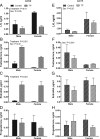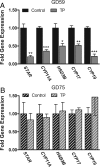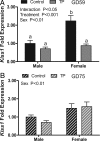Excess Testosterone Exposure Alters Hypothalamic-Pituitary-Testicular Axis Dynamics and Gene Expression in Sheep Fetuses
- PMID: 27673555
- PMCID: PMC5086533
- DOI: 10.1210/en.2016-1411
Excess Testosterone Exposure Alters Hypothalamic-Pituitary-Testicular Axis Dynamics and Gene Expression in Sheep Fetuses
Abstract
Prenatal exposure to excess androgen may result in impaired adult fertility in a variety of mammalian species. However, little is known about what feedback mechanisms regulate gonadotropin secretion during early gestation and how they respond to excess T exposure. The objective of this study was to determine the effect of exogenous exposure to T on key genes that regulate gonadotropin and GnRH secretion in fetal male lambs as compared with female cohorts. We found that biweekly maternal testosterone propionate (100 mg) treatment administered from day 30 to day 58 of gestation acutely decreased (P < .05) serum LH concentrations and reduced the expression of gonadotropin subunit mRNA in both sexes and the levels of GnRH receptor mRNA in males. These results are consistent with enhanced negative feedback at the level of the pituitary and were accompanied by reduced mRNA levels for testicular steroidogenic enzymes, suggesting that Leydig cell function was also suppressed. The expression of kisspeptin 1 mRNA, a key regulator of GnRH neurons, was significantly greater (P < .01) in control females than in males and reduced (P < .001) in females by T exposure, indicating that hypothalamic regulation of gonadotropin secretion was also affected by androgen exposure. Although endocrine homeostasis was reestablished 2 weeks after maternal testosterone propionate treatment ceased, additional differences in the gene expression of GnRH, estrogen receptor-β, and kisspeptin receptor (G protein coupled receptor 54) emerged between the treatment cohorts. These changes suggest the normal trajectory of hypothalamic-pituitary axis development was disrupted, which may, in turn, contribute to negative effects on fertility later in life.
Figures







Similar articles
-
Pituitary and testis responsiveness of young male sheep exposed to testosterone excess during fetal development.Reproduction. 2013 May 21;145(6):567-76. doi: 10.1530/REP-13-0006. Print 2013 Jun. Reproduction. 2013. PMID: 23579187
-
Chronic administration of the metastin/kisspeptin analog KISS1-305 or the investigational agent TAK-448 suppresses hypothalamic pituitary gonadal function and depletes plasma testosterone in adult male rats.Endocrinology. 2012 Nov;153(11):5297-308. doi: 10.1210/en.2012-1388. Epub 2012 Oct 1. Endocrinology. 2012. PMID: 23027808
-
Delayed onset of puberty in male offspring from bisphenol A-treated dams is followed by the modulation of gene expression in the hypothalamic-pituitary-testis axis in adulthood.Reprod Fertil Dev. 2017 Nov;29(12):2496-2505. doi: 10.1071/RD17107. Reprod Fertil Dev. 2017. PMID: 28641706
-
Role of GnRH in the ontogeny and regulation of the fetal hypothalamo-pituitary-gonadal axis in sheep.J Reprod Fertil Suppl. 1995;49:163-75. J Reprod Fertil Suppl. 1995. PMID: 7623311 Review.
-
Minireview: kisspeptin neurons as central processors in the regulation of gonadotropin-releasing hormone secretion.Endocrinology. 2006 Mar;147(3):1154-8. doi: 10.1210/en.2005-1282. Epub 2005 Dec 22. Endocrinology. 2006. PMID: 16373418 Review.
Cited by
-
Early prenatal androgen exposure reduces testes size and sperm concentration in sheep without altering neuroendocrine differentiation and masculine sexual behavior.Domest Anim Endocrinol. 2018 Jan;62:1-9. doi: 10.1016/j.domaniend.2017.07.001. Epub 2017 Jul 29. Domest Anim Endocrinol. 2018. PMID: 28843181 Free PMC article.
-
The GnRH Antagonist Degarelix Suppresses Gonadotropin Secretion and Pituitary Sensitivity in Midgestation Sheep Fetuses.Endocrinology. 2022 Feb 1;163(2):bqab262. doi: 10.1210/endocr/bqab262. Endocrinology. 2022. PMID: 34958103 Free PMC article.
-
Programmed for Preference: The Biology of Same-Sex Attraction in Rams.Neurosci Biobehav Rev. 2020 Jul;114:12-15. doi: 10.1016/j.neubiorev.2020.03.032. Epub 2020 Apr 18. Neurosci Biobehav Rev. 2020. PMID: 32311371 Free PMC article. Review.
-
Developmental programming: Impact of preconceptional and gestational exposure to a real-life environmental chemical mixture on maternal steroid, cytokine and oxidative stress milieus in sheep.Sci Total Environ. 2023 Nov 20;900:165674. doi: 10.1016/j.scitotenv.2023.165674. Epub 2023 Jul 25. Sci Total Environ. 2023. PMID: 37495149 Free PMC article.
-
Effect of Fetal Pituitary-Testes Suppression on Brain Sexual Differentiation and Reproductive Function in Male Sheep.Endocrinology. 2023 Aug 28;164(10):bqad129. doi: 10.1210/endocr/bqad129. Endocrinology. 2023. PMID: 37610243 Free PMC article.
References
-
- Ford JJ, D'Occhio MJ. Differentiation of sexual behavior in cattle, sheep, and swine. J Anim Sci. 1989;67:1816–1823. - PubMed
-
- Wood RI, Foster DL. Sexual differentiation of reproductive neuroendocrine function in sheep. Rev Reprod. 1998;3:130–140. - PubMed
-
- Clarke IJ, Scaramuzzi RJ, Short RV. Effects of testosterone implants in pregnant ewes on their female offspring. J Embryol Exp Morph. 1976;36:87–99. - PubMed
MeSH terms
Substances
Grants and funding
LinkOut - more resources
Full Text Sources
Other Literature Sources

